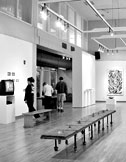|

Comment
on this story
What:
School of Art Faculty Exhibition
Where:
UT's Ewing Gallery, the Art & Architecture Building, 1715 Volunteer Blvd.
When:
Through Nov. 17. Call 974-3200 for hours
|
|

Art faculty members show us what they've got
by Heather Joyner
Ah, yes. Another UT School of Art faculty exhibit. You'd think by now—with numerous professors into their third and fourth decades of teaching—that they'd get a little tired. On the contrary, this year's show may be the best yet, reminding us that many artists and mentors get better with age. In the Ewing Gallery is the rarefied atmosphere of accomplishment, one in which almost two dozen participants working in ceramics, drawing, graphic design, media arts, photography, printmaking, and sculpture present an astonishing variety of pieces. This, after all, is where they've arrived for the time being, and what they've produced should impress gallery-goers.
As usual, sculpture dominates the gallery, and in this show it's undeniably daring. Jennifer Odem commands the middle of the space with her "Opened Ground," a 23-foot-long steel platform with artificial grass divided into eight plots. Each section contains an amber-colored rubber object, and platform legs have "feet" made from pitchers, cups, creamers, and the like. The piece is a synthesis of manmade objects attempting to look natural. "Through an integration of materials and forms that allude physically and metaphorically to human characteristics, I am questioning the varied ways in which we appropriate [and exploit] land," Odem says. That sounds like a reach, but "Opened Ground" manages to comment upon our culture of consumerism and denial.
Jason S. Brown confronts the notion of "natural" with an absurdist's flair. It could be that Brown's R.I.S.D. background has inspired objects with questionable uses, however authoritative their appearance. A tremendous double ladder rests, perfectly balanced, on the floor. The ladder sections lead nowhere, contradicting their essential function. Likewise, a shovel hung on the wall has a curved handle so long that it reaches back toward its scoop, rendering it useless. Although "How Crooked Is The Man?" salutes Marcel Duchamp's snow shovel, I've never seen anything quite like it. Brown's opposing "aesthetic survival device" tents manned by a fellow in a yellow suit and hard hat are accompanied by a promo piece showing them placed alongside "transportation corridors." Their humor is profound and delightful at the same time.
The show's ceramic work is unusual, particularly Sally Brogden's otherworldly, metallic-glazed pod-like object and untitled clay pieces resembling clustered eggs. All are sensuous and fertile-looking, and it's hard to keep one's hands to one's self. Blain's dozen mounted log shapes titled "Curbside Environment: Laurel" are vertically stacked and crowded with elements reminiscent of octopus tentacles, and her colors are harmonious but not boring. Frank Martin's functional vessels and plates serve as vehicles for energetic abstract painting.
Selected printmaking and design efforts reflect—as always—each program's high standards. Beauvais Lyons' "Planche X" (showing what appears to be eye surgery depicted cartoon-style) is hung amidst amusing-as-ever imaginary organs. Print-based mixed media images by Anita Jung also emphasize a mysterious brand of "art as information." Filled with what the artist acknowledges as nostalgia and cliché, they reference "women's involvement in historical and contemporary craft practices." Design projects run from traditional but exquisite printed pieces by Deborah Shmerler to DVD menu screens by Sarah Lowe. Wade Lough's "posters" and Cary Staples' electronic media layouts complete the offerings.
Baldwin Lee's composite photographs related to September 11 are even more striking than they were at the KMA [Artbeat, Sept. 5]. The new Art Department Director Paul Lee (no relation) presents large-scale, paired color images from digital video. Each diptych shows in an unsettling way what could be military aircraft hugging the horizon. Says Lee, "As an artist, I translate my personal feelings and knowledge of my surroundings into a visual language for others to decode." A similarly large computer-altered "Duracel" photographic print by Michael Brakke is what he calls "unreasonably beautiful." It reveals an ambiguous interior space—perhaps the inside of a machine. Immersed in bright color, we need not understand precisely what we're looking at.
Of his art, Norman Magden states, "My works involve the creation of multi-image performances in which...performers interact with the projected images...." Seen inside an alcove, the projections are flanked by six stills that are intriguing in and of themselves.
Also defying easy definition is the "drawing" by David Wilson. Made with a red silly string-like substance adhered to the wall, the installation is linear but slightly raised—sort of like freshly-tattooed skin. Wilson's remark that "a sense of open play is essential" is herein illustrated via his approach.
Of the painters, about all I can say of most works is "Wow." Marcia Goldenstein and Tom Riesing present grouped images that act both as parts and as a whole. The attention they call to the picture plane reminds us that the handling of paint is the ultimate subject. Whitney Leland's seductive acrylic surfaces use squiggle shapes to break up space, and despite being less "slick," his watercolors are equally visually fascinating. Clark Stewart continues along a narrative/figurative path, applying paint and colored pencil to masonite. His frames made from sticks and driftwood have a vulval shape reinforcing his themes of feminine power. He says, "These stories are loose enough to let the viewer extrapolate meanings relative to their own experiences.... [T]he capriciousness of elements like the frames reference folk art, however loosely." Sam Yates adds to the mix his "Stalemate," a large surrealist canvas with two men arm-wrestling over a chessboard by the sea.
I'd love to see the bulk of the show—totaling approximately $66,000—permanently displayed in the new convention center, making up for its exclusion of all individuals above. Such an addition would be the deal of the century.

October 31, 2002 * Vol. 12, No. 44
© 2002 Metro Pulse
|